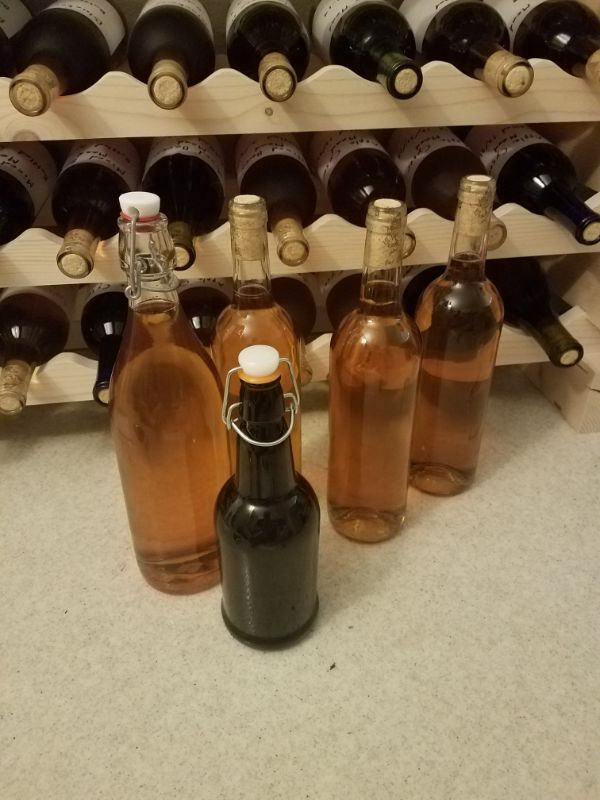A rich mead made using Rooibos tea and Stumptown Cold Brew Coffee.
Originally Posted: Aug. 8, 2020

Table of Contents
Quick Specs
- OG = 1.105
- ABV: ~13.8%
- Taste Profile: Strong and semi-sweet coffee flavor with rooibos and vanilla in the background
- Time: about 5 months
- Yield: ended up with just over 30 bottles
Intro
My Rooibos-Coffee mead “Café Fynbos” was directly inspired by a mead I discovered one day circa 2012 at a QFC grocery store near University of Washington. For years, that single store was the only place I could find that mead, and only if I was lucky. A few years later when I had moved to the East Side, I found a bottle and tap shop in Redmond that carried it more consistently.
In the Eastern Cape region of South Africa, Makana Meadery makes a mead called “Honey Sun iQhilika African Coffee Mead”[1]. My other favorite drink to come out of South Africa is rooibos tea. I decided I wanted to try and combine the two into my own homebrewed beverage.

Brief History
Mead has been produced in various regions in Africa for thousands of years; if you’ve read any books or articles on the history of mead or regional mead styles, you may have come across the Ethiopian and Eritrean variant: T’ej. Mead has also been produced in South Africa, where the native Xhosa name for it is “iQhilika”[2] and the Khoisan name is “karri”[3].

Ingredients
- 15 lbs. Trader Joe’s Mesquite honey (they used to sell it in 3 lb. cans, but I haven’t seen that in a while. Nevertheless, Mesquite honey is my favorite for this mead)
- 5 gallons of spring water
- A whole box of bagged Rooibos tea (you could use the equivalent weight of loose-leaf but put it in a tight-mesh bag). I think I put half in on primary and half on secondary or something. Worth experimenting with amounts.
- 6 bottles of Stumptown Cold-Brew coffee, on secondary (or your favorite cold-brew coffee).
- 1 whole vanilla bean, on secondary
- Yeast nutrient & raisins
- Wine or mead yeast (I think I used Lalvin EC-1118, but I didn’t write it down anywhere in my notes)
Equipment
- Sanitizer
- Fermenter
- Airlock and stopper
- Sous vide circulator (optional, to warm honey)
Instructions
- Optional: Warm the honey per your preferred method to make it easier to pour (try and keep it below 95°F (35°C)).
- Mix 10 – 12 lbs. of the honey (depending on if you were able to buy it in 3- or 5-lb. increments), spring water, yeast nutrient, and (optionally) half of the rooibos bags. Pitch desired yeast.
- Attach blow-off tube in place of an airlock (optional, but often worth it). Once fermentation slows, you can swap this out for a regular airlock if you want.
- Wait for primary fermentation to slow (about a week), then add remaining honey.
- Once fermentation has slowed significantly (another 2 – 3 weeks maybe?) transfer mead onto remaining rooibos bags and vanilla bean.
- Cold-brew coffee can be added at this point as well, or it can be added right before bottling.
Variations
Honestly, I think this one turns out perfectly the way it is. Might be worth adding even more rooibos on secondary, or even making a rooibos vodka tincture to concentrate the flavor and add at the end. Honeybush (also from South Africa) could be another potential additive. An extra vanilla bean might be nice too.
I’ve also thought about experimenting with adding the coffee flavor a few different ways: whole bean or roughly ground instead of using cold brew.
A bochet-style mead might compliment coffee flavor well, but you may need to add a lot more rooibos and vanilla if you don’t want them to be overshadowed by the caramelized honey. A rooibos tincture might help you get more intense flavor before bottling in that case.
Tips & Tricks
Sometimes this mead will have a vigorous primary fermentation at the beginning. A blow-off tube is advisable just in case. I think that yeast really likes something in rooibos.
Possible Culinary Uses
I haven’t given this one as much thought as some of my other meads, but perhaps it would be a good one to add to a brine or marinade for coffee-rubbed steak or pork. It might also be good in a slow-cooked or smoked pulled pork recipe.
End Notes
-
https://untappd.com/b/makana-meadery-honey-sun-iqhilika-african-coffee-mead/732431 ↑
___________ -
https://www.homebrewersassociation.org/attachments/presentations/pdf/2014/Mead%20Past%20&%20Present.pdf ↑
___________ -
https://www.fondazioneslowfood.com/en/ark-of-taste-slow-food/khoisan-honey-mead/ ↑










